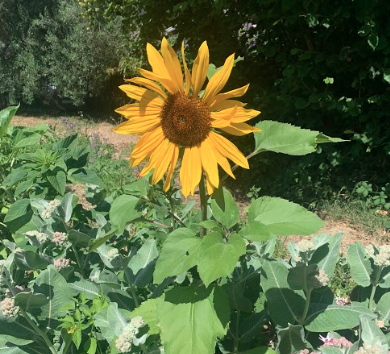
How Matter Moves in an Ecosystem
Summary:
In this lesson, students take a deep dive into exploring how energy and matter move through a garden ecosystem. Students start by defining and observing examples of matter in the garden ecosystem. Then they think critically about where the matter in a garden ecosystem comes from, and whether it could ever run out. This lesson forms the foundation for lesson 11, Compost, in which students will explore the role of compost and decomposition in a garden ecosystem.
Download Lesson Plan
Teaching Notes:
- For sections that instruct students to READ, you can record yourself reading aloud and send it to students. Invite them to read along with the recording. This is a helpful strategy for differentiating learning that supports all students.
- If you are teaching this lesson in the garden, we suggest completing the sections as a whole glass or in small groups. The garden is a great place for discussion-based lessons.
- This lesson is designed both to help students start to wrap their heads around this project in a more structured way, but also to prompt excitement and enthusiasm about the driving question. Encourage students to really get all their thinking on the table here, especially during the brainstorm section. At this stage in the process, the more possibilities the better! You never know what kind of creative solutions or ideas may arise from something that at first seems completely unrealistic or “out there”.
- The “READ” section of this lesson may feel a little dense to some students without the proper support. We suggest the following strategies for supporting students to engage fully with the text:
- Instruct students to find a quiet place to sit and encourage them to observe their surroundings before and after they read. This helps them engage with their surroundings in a different way and can also support their engagement with the text.
- Assign sections of the reading as a jigsaw: Assign small groups a different topic each, and then have groups report back to one another after they have finished reading with their topic in mind.
- Remind students that the Talk to the Text or T4 strategy can be used when reading texts to help track their thoughts, questions, and reactions to a text. In these strategies, students write notes and ask questions in the margins, underline words, and use symbols to react to the text.
- Read the article aloud and have students take notes as they listen. It might be helpful to stop frequently as you read to write down keywords, phrases, or ideas on chart paper. Take your time through the reading and ask your students their thoughts along the way.
- The first PAIR SHARE in this lesson asks students to track the source of matter in their own bodies, and in crops. Students should have a basic idea about how to answer these questions based on things they learned in elementary school science classes. However, we recommend you use this pair-share as a way to gauge your students’ level of prior knowledge, and identify any significant misconceptions. Science instruction in elementary school tends to be inconsistent, and so there may be less background knowledge for some students than others.
- At some point during this lesson, have students return to the garden bed in which they are conducting the plant start investigation (Lesson 3). They should record their observations about the plants and soil on the Plant Start Investigation worksheet.




